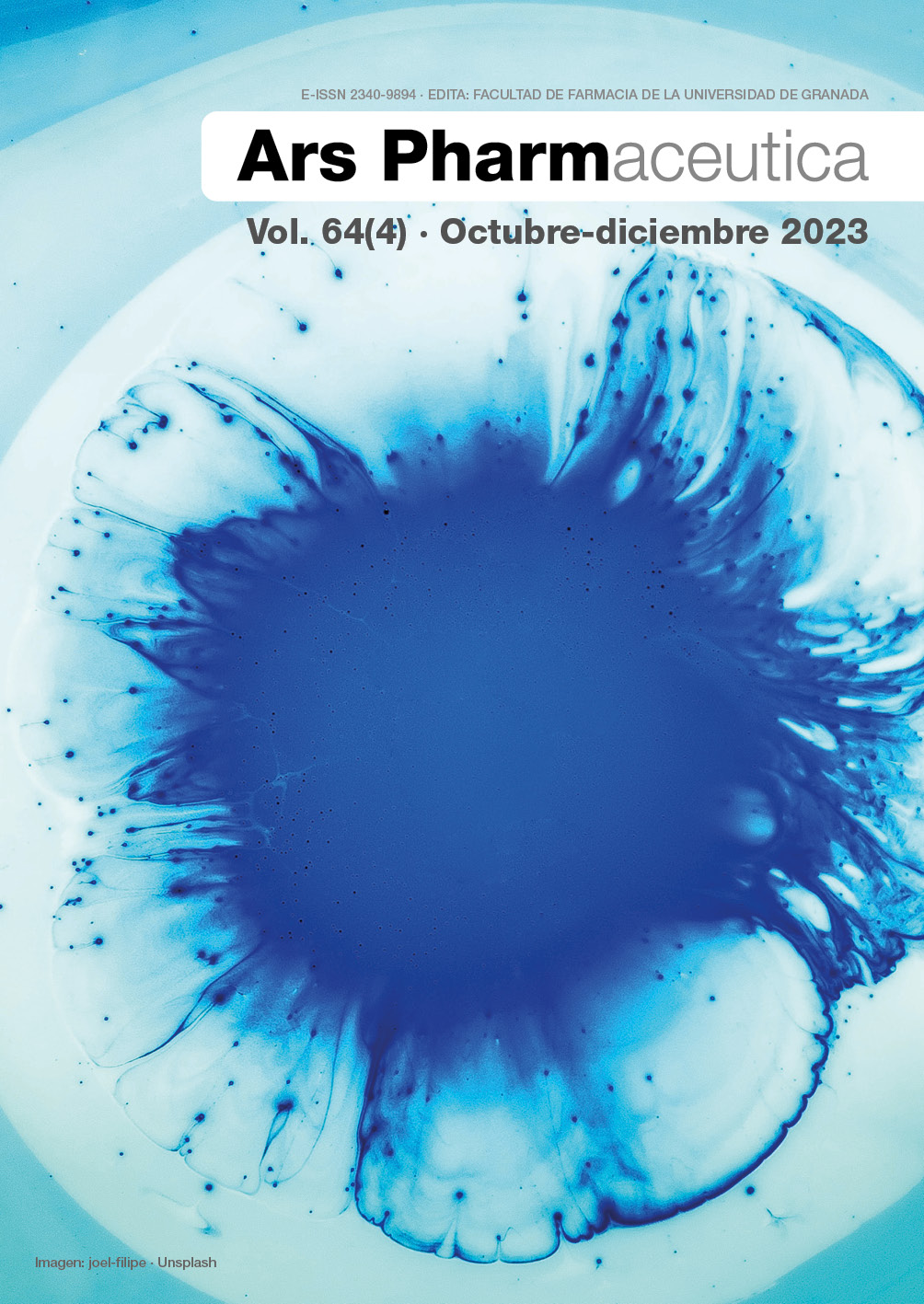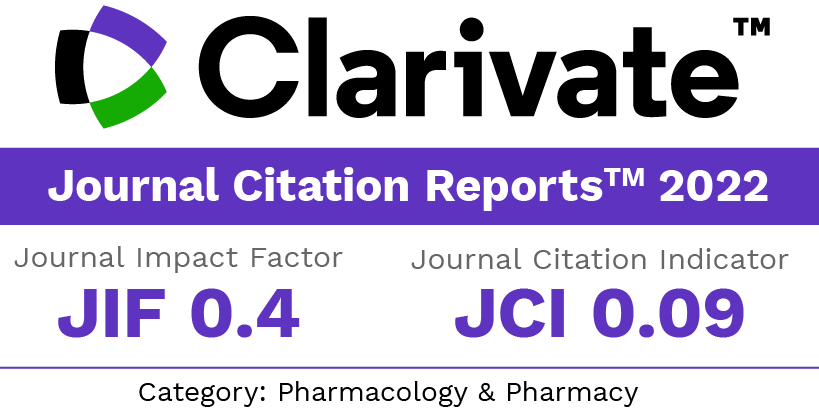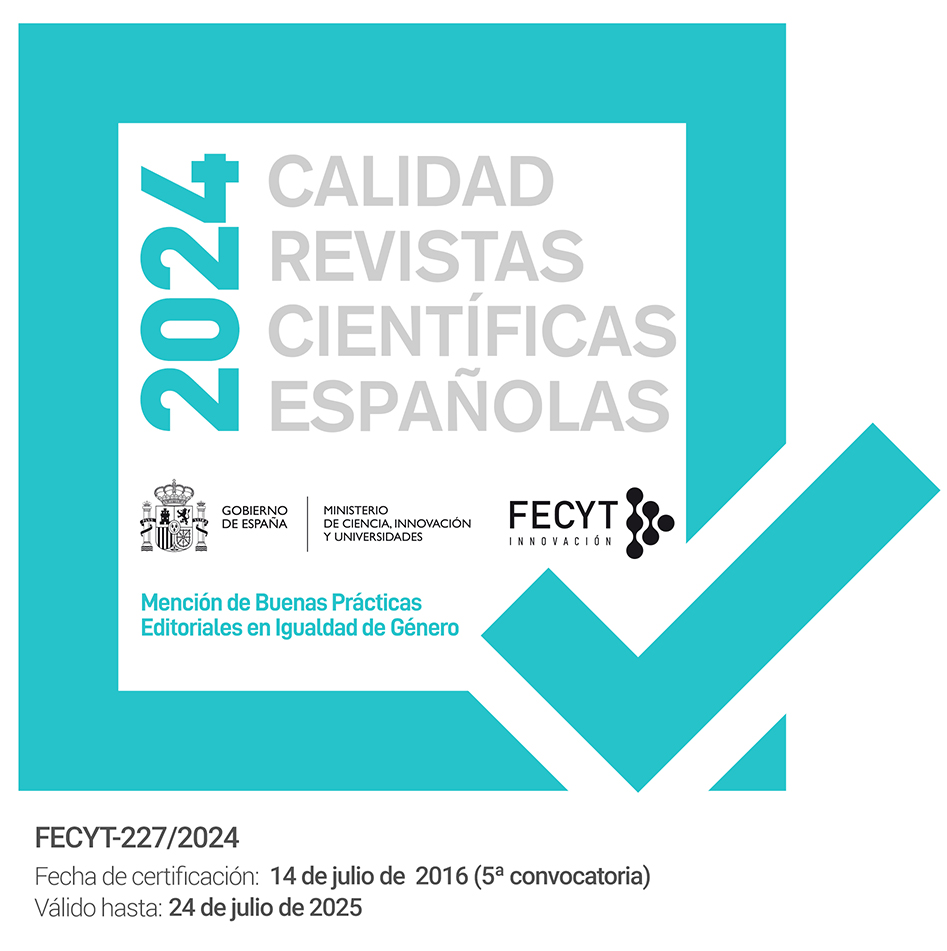Aquasomal drug delivery system: A special emphasis on the formulation techniques and applications
DOI:
https://doi.org/10.30827/ars.v64i4.28264Keywords:
Aquasomes, nanotechnology, self-assembly, ceramic nanoparticles, calcium phosphateAbstract
Introduction: Aquasome is a self-assembled nanoparticulate carrier system with three layers. The system is made up of a polyhydroxy oligomer-coated inner nanocrystalline solid core. Adsorbed on the coated layer are drug molecules or biochemically active compounds. Self-assembly in this sense refers to the independent formation of molecules into organised, long-lasting, and non-covalently bonded patterns.This paper gives an overview of aquasome formation, covering structural properties, formulation methodologies, and the benefits and drawbacks of this novel drug delivery technology. The article primarily addresses the formulation processes used to create self-assembled nanostructures and their various possible applications.
Method: Several online databases, including Science Direct, Medline, Web of Science, Google Scholar and Scopus, were used in the literature search. The datasets were searched for entries of studies up to July, 2023. The review paper especially addresses many elements of aquasome formation by various researchers employing methods/modified techniques such as co-precipitation, self-precipitation, sputtering, and and so forth. It also illustrates a variety of fields of therapy in which aquasome has been recognised to have a major influence, such as oxygen and extract carrier.
Results: The solid core is responsible for providing structural stability, while the oligomeric coating is crucial for safeguarding against dehydration and stabilising the bioactive molecules. This biodegradable drug delivery vehicle at the nanoscale level exhibits a tendency to accumulate in the liver and muscles. The non-modification of drug adsorption onto the aquasome surface facilitates prompt pharmacological response by allowing unobstructed receptor recognition at the action site.
Conclusions: Aquasome, a three-layered self-assembled molecule, is a simple yet new drug delivery system with promising carrier potentials to increase the solubility and bioavailability of poorly soluble drugs. Despite a host of challenges, such as time consumption, sophisticated processes, safety, and expensive research costs, aquasome may emerge as an alternative vesicular carrier in the future.
Downloads
References
Homayun B, Lin X, Choi HJ. Challenges and recent progress in oral drug delivery systems for biopharmaceuticals. Pharmaceutics. 2019;11(3):129. Doi:10.3390/pharmaceutics11030129.
Antil R, Kadawla M, Rao L. Recent advances in aquasomes carrier nanotechnology for drug delivery. Int J Nanobiotechnol. 2021;7(1):35-44.
Sarangi MK, Padhi S. Novel herbal drug delivery system: An overview. Arch Med Health Sci. 2018;6(1):171-179. Doi: 10.4103/amhs.amhs_88_17.
Samson K, Varalakshmi M, Prathima K. Aquasomes: A vesicular, self-assembled ceramic nano-particulate drug carrier. Res Rev J Pharm Sc.2021;12(3):1-14.
Alenzi AM, Albalawi SA, Alghamdi SG, Albalawi RF, Albalawi HS, Qushawy M. Review on different vesicular drug delivery systems (VDDSs) and their applications. Recent Pat Nanotechnol. 2023;17(1):18-32. Doi: 10.2174/1872210516666220228150624.
Bayda S, Hadla M, Palazzolo S, Riello P, Corona G, Toffoli G, Rizzolio F. Inorganic nanoparticles for cancer therapy: a transition from lab to clinic. Curr Med Chem. 2018;25(34):4269-4303. Doi: 10.2174/0929867325666171229141156.
Pavani V, Dintakurthi S, Aslam S, Gollagudem R, Pabbapi K. Aquasomes: a novel drug carrier system. ChemInform. 2012;3(4):123-127.
Luther DC, Huang R, Jeon T, Zhang X, Lee YW, Nagaraj H, Rotello VM. Delivery of drugs, proteins, and nucleic acids using inorganic nanoparticles. Adv Drug Deliv Rev. 2020;156:188-213. Doi: 10.1016/j.addr.2020.06.020.
Kossovsky N, Gelman A, Rajguru S, Nguyen R, Sponsler E, Hnatyszyn H, Chow K, Chung A, Torres M, Zemanovich J. Control of molecular polymorphisms by a structured carbohydrate/ceramic delivery vehicle—aquasomes. J Control Release. 1996;39(2-3):383-388. Doi: 10.1016/0168-3659(95)00169-7.
Upadhyay P, Singh D, Upadhyay S. Vesicular approach review on nanocarriers bearing curcumin and applications. Recent Adv Drug Deliv Formul. 2022. Doi: 10.2174/2667387816666220404092415.
Kossovsky N, Gelman A, Sponsler EE, Hnatyszyn HJ, Rajguru S, Torres M, Pham M, Crowder J, Zemanovich J, Chung A. Surface-modified nanocrystalline ceramics for drug delivery applications. Biomaterials 1994;15(15):1201-1207. Doi: 10.1016/0142-9612(94)90270-4
Mesariya S, Joshi K, Jain H, Upadhyay UM. Aquasomes- A self-assembled nanotechnology system. Int J Res Pharm Sci. 2011;2(3):492-496.
Kaushik JK, Bhat R. Why Is Trehalose an Exceptional Protein Stabilizer?: An analysis of the thermal stability of proteins in the presence of the compatible osmolyte trehalose. J Biol Chem. 2003;278(29):26458-26465. Doi: 10.1074/jbc.M300815200.
Reulecke I, Lange G, Albrecht J, Klein R, Rarey M. Towards an integrated description of hydrogen bonding and dehydration: decreasing false positives in virtual screening with the HYDE scoring function. ChemMedChem. 2008; 3(6):885-897. Doi: 10.1002/cmdc.200700319.
Jagdale S, Karekar S. Bird’s eye view on aquasome: Formulation and application. J Drug Deliv Sci Technol. 2020;58:1017-76. Doi.:10.1016/j.jddst.2020.101776.
Jain SS, Jagtap PS, Dand NM, Jadhav KR, Kadam VJ. Aquasomes: A novel drug carrier. J Appl Pharm Sci. 2012;2(01):184-192.
Haberland M, Fless G, Scanu A, Fogelman AM. Malondialdehyde modification of lipoprotein (a) produces avid uptake by human monocyte-macrophages. J Biol Chem. 1992;267(6):4143-4151.
Kajbafvala A, Bahmanpour H, Maneshian MH, Li M. Self-assembly techniques for nanofabrication J Nanomater. 2013. Doi:10.1155/2013/158517
Li LL, An HW, Peng B, Zheng R, Wang H. Self-assembled nanomaterials: design principles, the nanostructural effect, and their functional mechanisms as antimicrobial or detection agents. Mater Horiz. 2019;6(9):1794-1811. Doi:10.1039/C8MH01670D.
Mishra DK, Shandilya R, Mishra PK. Lipid based nanocarriers: a translational perspective. Nanomed: Nanotechnol Biol Med. 2018;14(7):2023-2050. Doi: 10.1016/j.nano.2018.05.021.
Kulkarni S, Prabhakar B, Shende P. Aquasomes: Advanced Vesicular-based Nanocarrier Systems. Curr Pharm Des. 2022;28(29):2404-2414. Doi: 10.2174/1381612828666220728112741.
Pataquiva MA, Pia FM Monteiro FJ. Nanoparticles of hydroxyapatite: Preparation, characterization and cellular approach-an overview. Revista Mutis. 2017;3(2):43-57. Doi:10.21789/22561498.884.
Paul W, Sharma CP. Bioceramics, towards nano-enabled drug delivery: a mini review. Trends Biomater Artif Organs. 2005;1:7-11.
Jain S, Jain V, Mahajan S. Lipid based vesicular drug delivery systems. Adv. Pharm. 2014. Doi:10.1155/2014/574673
Correia R, Magalhaes M, Marques P, Senos A. Wet synthesis and characterization of modified hydroxyapatite powders. J Mater Sci Mater Med. 1996;7(8):501-505. Doi:10.1007/BF00705432.
Patil S, Pancholi S, Agrawal S, Agrawal G. Surface-modified mesoporous ceramics as delivery vehicle for haemoglobin. Drug Deliv. 2004;11(3):193-199. Doi: 10.1080/10717540490433976.
Vengala P, Dintakurthi S, Subrahmanyam CVS. Lactose coated ceramic nanoparticles for oral drug delivery. J Pharm Res. 2013;7(6):540-545. Doi:10.1016/j.jopr.2013.06.015.
Khopade A, Khopade S, Jain N. Development of hemoglobin aquasomes from spherical hydroxyapatite cores precipitated in the presence of half-generation poly (amidoamine) dendrimer. Int. J. Pharm. 2002;241(1):145-154. Doi: 10.1016/s0378-5173(02)00235-1.
Kim HM, Kokubo T, Miyazaki T, Nakamura T. Revised simulated body fluid. Key Eng Mater. 2001, 192-195.
Kossovsky N, Bunshah RF, Gelman A, Sponsler E, Umarjee DM, Suh TG, Prakash S, Doerr HJ, Deshpandey CV. A nondenaturing solid phase pharmaceutical carrier comprised of surface‐modified nanocrystalline materials. J Appl Biomater. 1990;1(4):289-294. Doi: 10.1002/jab.770010404.
Kommineni S, Ahmad S, Vengala P, Subramanyam C. Sugar coated ceramic nanocarriers for the oral delivery of hydrophobic drugs: Formulation, optimization and evaluation. Drug Dev Ind Pharm. 2012;38(5):577-586. Doi: 10.3109/03639045.2011.617884.
Wingler A. The function of trehalose biosynthesis in plants. Phytochem. 2002;60(5):437-440. Doi: 10.1016/s0031-9422(02)00137-1.
Almeida IS, Cardoso LA, Santos DM, Torné JM, Fevereiro PS. Trehalose and its applications in plant biotechnology. In Vitro Cell Dev Biol Plant. 2007;43(3):167-177. doi: 10.1007/s11627-006-9024-3.
Bunaciu AA, Aboul-Enein HY, Fleschin S. Application of Fourier transform infrared spectrophotometry in pharmaceutical drugs analysis. Appl Spectrosc Rev. 2010;45(3): 206-219. Doi:10.1080/00387011003601044.
Narang N. Aquasomes: Self-assembled systems for the delivery of bioactive molecules. Asian J Pharm. 2012; 6(2). Doi:10.22377/ajp.v6i2.61
Goyal AK, Rawat A, Mahor S, Gupta PN, Khatri K, Vyas SP. Nanodecoy system: a novel approach to design hepatitis B vaccine for immunopotentiation. Int J Pharm. 2006;309(1-2):227-233. Doi: 10.1016/j.ijpharm.2005.11.037.
Ludwig TG, Goldberg HJ., The anthrone method for the determination of carbohydrates in foods and in oral rinsing. J Dent Res. 1956;35(1):90-94.
Vengala P. Carbohydrate stabilized ceramic nanoparticles for the delivery of a poorly soluble drug, lornoxicam. Asian J Pharm. 2017;11(03):S497-S503.
Vengala P, Subrahmanyam C, Gangaraju M. In vitro and in vivo evaluation of piroxicam loaded ceramic nanoparticles. Int. J. Pharmaceut. Sci. Res. 2016;7:303-309.
Singh A, Deep A. Formulation and evaluation of nanoparticles containing atenolol. Int J Pharm Res. 2011;3(4):59-62.
Waghule T, Rapalli VK, Singhvi G, Gorantla S, Khosa A, Dubey SK, Saha RN. Design of temozolomide-loaded proliposomes and lipid crystal nanoparticles with industrial feasible approaches: comparative assessment of drug loading, entrapment efficiency, and stability at plasma pH. J Liposome Res. 2021;31(2):158-168. Doi: 10.1080/08982104.2020.1748648.
Nebija D, Noe CR, Urban E, Lachmann B. Quality control and stability studies with the monoclonal antibody, trastuzumab: application of 1D-vs. 2D-gel electrophoresis. Int J Mol Sci. 2014;15(4):6399-6411. Doi: 10.3390/ijms15046399.
Bellad K, Nanjwade B, Sarkar A, Srichana T, Shetake R. Development and evaluation of curcumin floating tablets. Pharm Anal Acta. 2020;12:622. Doi: 10.35248/2153-2435.20.11.622.
Mishra A, Patra S, Shukla SK, Pandey P, Shukla Y, Osmera P, Yadav P, Pandey M, Gupta R, Molina F. Current scenario of coronavirus pandemic. Adv Mater Lett. 2020;11(4):1-8.
Kaur K, Kush P, Pandey RS, Madan J, Jain UK, Katare OP. Stealth lipid coated aquasomes bearing recombinant human interferon-α-2b offered prolonged release and enhanced cytotoxicity in ovarian cancer cells. Biomed Pharmacother. 2015;69;267-276. Doi: 10.1016/j.biopha.2014.12.007.
Cherian AK, Rana A, Jain SK. Self-assembled carbohydrate-stabilized ceramic nanoparticles for the parenteral delivery of insulin. Drug Dev Ind Pharm. 2000;26(4):459-463. Doi: 10.1081/ddc-100101255.
Goyal AK, Khatri K, Mishra N, Mehta A, Vaidya B, Tiwari S, Vyas SP. Aquasomes-a nanoparticulate approach for the delivery of antigen. Drug Dev Ind Pharm. 2008;34(12):1297-1305. Doi: 10.1080/03639040802071661.
Rojas-Oviedo I, Salazar-Lopez RA, Reyes-Gasga J, Quirino-Barreda CT. Elaboration and structural analysis of aquasomes loaded with indomethacin. Eur. J. Pharm. Sci. 2007;32(3):223-230. Doi: 10.1016/j.ejps.2007.07.008.
Vengala P, Shwetha D, Sana A, Rekha G, Kumaraswamy P. Aquasomes: a novel drug carrier system. Int Res J Pharm. 2012;3(4):123-127.
Goyal AK, Khatri K, Mishra N, Mehta A, Vaidya B, Tiwari S, Paliwal R, Paliwal S, Vyas SP. Development of self-assembled nanoceramic carrier construct (s) for vaccine delivery. J Biomater Appl. 2009;24(1):65-84. Doi: 10.1177/0885328209104018.
Khan S, Tiwari T, Tyagi S, Bhowmik M, Joshi A, Dubey B. Preformulation studies and preperation of dithranol loaded solid lipid nanoparticles. Int J Res Dev Pharm L Sci. 2012;4:183-88.
Nanjwade BK, Hiremath GM, Manvi F, Srichana T. Formulation and evaluation of etoposide loaded aquasomes. J Nanopharm Drug Deliv.2013;1(1):92-101.
Kutlehria A, Koushik P, Sharma S, Kaur A. Aquasomes as a carrier system for oral delivery of bromelain. Int Res J Pharm. 2018;9(8):123-129. Doi:10.7897/2230-8407.098177.
Umashankar MS, Sachdeva RK, Gulati M. Aquasomes: a promising carrier for peptides and protein delivery. Nanomedicine: Nanotechnol Biol Med. 2010;6(3):419-426. Doi: 10.1016/j.nano.2009.11.002.
Rawat M, Singh D, Saraf S, Saraf S. Development and in vitro evaluation of alginate gel–encapsulated, chitosan-coated ceramic nanocores for oral delivery of enzyme. Drug Dev Ind Pharm. 2008;34(2):181-188. Doi:10.1080/03639040701539479.
Mizushima Y, Ikoma T, Tanaka J, Hoshi K, Ishihara T, Ogawa Y, Ueno A. Injectable porous hydroxyapatite microparticles as a new carrier for protein and lipophilic drugs. J Control Release. 2006;110(2):260-265. Doi:10.1016/j.jconrel.2005.09.051.
Banerjee S, Sen KK. Preparation and evaluation of surface modified nanoparticles of calcium phosphate as extract carrier. Int J Appl Pharm. 2020;12(4):248–257. Doi:10.22159/ijap.2020v12i4.38126.
Asfour MH. Advanced trends in protein and peptide drug delivery: a special emphasis on aquasomes and microneedles techniques. Drug Deliv Transl Res. 2021;11(1):1-23.Doi: 10.1007/s13346-020-00746-z.
Gupta AK, Gupta D, Gupta V. Aquasomes: A Self-Assembled Nano-Particulate Carrier System. Int J Cur Res Rev. 2021;13(4):44-52. Doi:10.31782/IJCRR.2021.13427.
Patel S, Aundhia C, Seth A, Shah N, Pandya K, Patel D. Aquasomes: a novel approach in drug carrier system. European J Pharm Med Res. 2016;3(9):198-201.
Priya MDK, Kumar V, Damini VK, Eswar K, Reddy KR, Raj BS, Sucharitha P. SOMES: A review on composition, formulation methods and evaluations of different types of “SOMES” drug delivery system. Int J Appl Pharm. 2020;12(6):7-18. Doi:10.22159/ijap.2020v12i6.38996.
Downloads
Published
How to Cite
Issue
Section
License
Copyright (c) 2023 Prakash Rajak, Rofiqul Islam , Arka Karmakar, Biman Bhuyan

This work is licensed under a Creative Commons Attribution-NonCommercial-ShareAlike 4.0 International License.
The articles, which are published in this journal, are subject to the following terms in relation to the rights of patrimonial or exploitation:
- The authors will keep their copyright and guarantee to the journal the right of first publication of their work, which will be distributed with a Creative Commons BY-NC-SA 4.0 license that allows third parties to reuse the work whenever its author, quote the original source and do not make commercial use of it.
b. The authors may adopt other non-exclusive licensing agreements for the distribution of the published version of the work (e.g., deposit it in an institutional telematic file or publish it in a monographic volume) provided that the original source of its publication is indicated.
c. Authors are allowed and advised to disseminate their work through the Internet (e.g. in institutional repositories or on their website) before and during the submission process, which can produce interesting exchanges and increase citations of the published work. (See The effect of open access).























